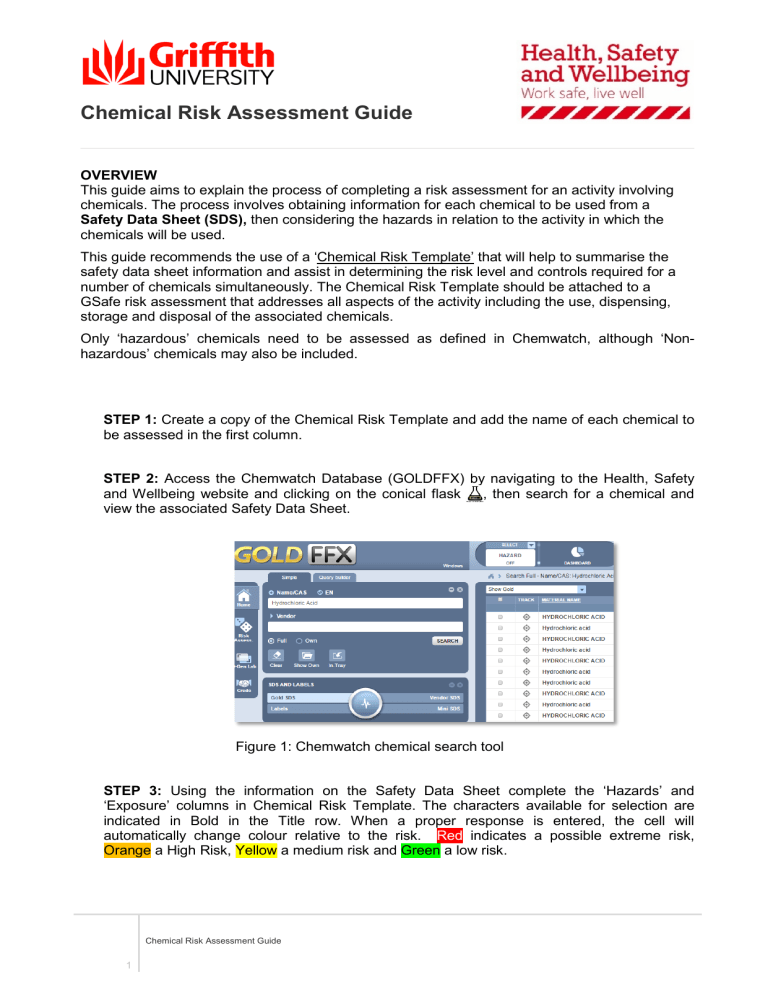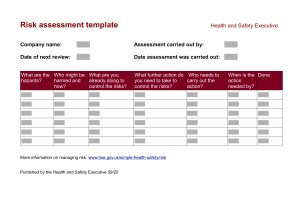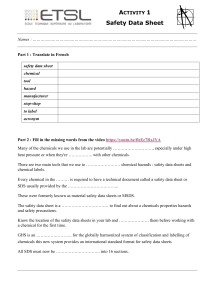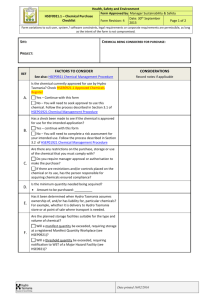
Chemical Risk Assessment Guide OVERVIEW This guide aims to explain the process of completing a risk assessment for an activity involving chemicals. The process involves obtaining information for each chemical to be used from a Safety Data Sheet (SDS), then considering the hazards in relation to the activity in which the chemicals will be used. This guide recommends the use of a ‘Chemical Risk Template’ that will help to summarise the safety data sheet information and assist in determining the risk level and controls required for a number of chemicals simultaneously. The Chemical Risk Template should be attached to a GSafe risk assessment that addresses all aspects of the activity including the use, dispensing, storage and disposal of the associated chemicals. Only ‘hazardous’ chemicals need to be assessed as defined in Chemwatch, although ‘Nonhazardous’ chemicals may also be included. STEP 1: Create a copy of the Chemical Risk Template and add the name of each chemical to be assessed in the first column. STEP 2: Access the Chemwatch Database (GOLDFFX) by navigating to the Health, Safety and Wellbeing website and clicking on the conical flask , then search for a chemical and view the associated Safety Data Sheet. Figure 1: Chemwatch chemical search tool STEP 3: Using the information on the Safety Data Sheet complete the ‘Hazards’ and ‘Exposure’ columns in Chemical Risk Template. The characters available for selection are indicated in Bold in the Title row. When a proper response is entered, the cell will automatically change colour relative to the risk. Red indicates a possible extreme risk, Orange a High Risk, Yellow a medium risk and Green a low risk. Chemical Risk Assessment Guide 1 Note: If the information for a particular column is not relevant or not available on the SDS simply leave that cell blank. You will need to consider your planned activity in conjunction with the SDS information to complete the last ‘Risk’ Columns. Refer to the example below. Substance Name Physical & Health Effect classifications Handling/Exposure Information Figure 2: Example Safety Data Sheet excerpts Figure 3: Example of completed ‘Hazards’ section of chemical risk template Chemical Risk Assessment Guide 2 STEP 4: Next complete the ‘Controls Available’ columns. Then based on the Hazards, Exposure and Controls identified, determine the overall level of “Risk’ and the “Action from Assessment” column for each chemical. You need to refer to the GU risk matrix at the end of this document in order to determine the overall risk level. Figure 4: Example of completed ‘Controls Available, ‘Risk’ & ‘Action from Assessment’ sections of the chemical risk template. STEP 5: Access GSafe and create a new ‘Risk Assessment’ within the WHS Risk Register. Complete the GSafe risk assessment in conjunction with the information you have collated and attach the ‘Chemical Risk Assessment Form’. The GSafe assessment should address all aspects of the activity including the use, dispensing, storage and disposal of the associated chemicals. Figure 5: GSafe Risk Assessment Chemical Risk Assessment Guide 3 GLOSSARY If you are unfamiliar with the definition of any terms used within a chemical risk assessment, then you can refer to the glossary available within Chemwatch as shown below: Figure 6: Chemwatch Glossary Tool FURTHER QUESTIONS If you still have questions email safety@griffith.edu.au with your query. Chemical Risk Assessment Guide 4 Risk Matrix Risk Rating Insignificant Minor Moderate Major Catastrophic No injuries* First Aid treatment* Medical treatment* Serious or extensive injuries* Death or large number of serious injuries* Almost Certain Low Medium High High Extreme Likely Low Medium Medium High High Possible Low Low Medium Medium High Unlikely Low Low Low Medium Medium Rare Low Low Low Low Medium Consequences Likelihood *These descriptors relate to health and safety risk ratings and are not part of the University Strategic Risk Table. Likelihood Rating The number of times within a specified period in which a risk may occur either as a consequence of business operations or through failure of operating systems, policies or procedures. Rating Description Occurrence Probability Almost Certain Expected to occur in most circumstances Multiple/12 months > 80% Likely Strong possibility of occurrence Within 12 months 61% – 80% Possible May occur occasionally Within 5 years 31% – 60% Unlikely Not expected to occur but may happen Within 10 years 5% – 30% Rare May only occur in exceptional circumstances >10 years <0 5% Prioritising Risks – Table of Management Action Risk Score Extreme High Medium Low What should I do? Immediate action required Action plan required, senior management attention needed Specific monitoring or procedures required, management responsibility must be specified Manage through routine procedures. Unlikely to need specific application of resources. Chemical Risk Assessment Guide 5



